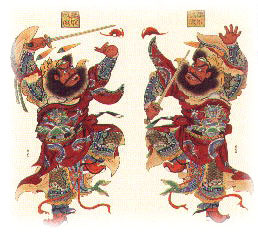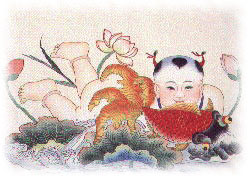Visual Arts -- Folk Prints
Folk prints are an everlasting part of China's culture. The prints depict the legends, religious imagery, and everyday lives of the Chinese people. Folk prints originated within popular Chinese culture, and their forms and content open a door into the outlook of the common person in China by illuminating the aspirations for a better life and the desire for recognition.

|
Folk prints can be divided into four categories based on content and function:
- the printed illustrations that can be found in local chronicles, various morality works, medical references, agricultural treatises, dramas, and albums;
- Chinese New Year prints;
- religious prints;
- a more miscellaneous category that would include seals of stores and other similar sundries.
The Chinese people have the custom of posting pictures to celebrate the New Year and as a result New Year prints are the most beloved among folk print creations. The tradition is particularly popular in the countryside, where just before the festival day every household is busy spring cleaning and pasting colorful pictures on their doors, windows, walls, wardrobes, and stoves.

|
Religious Prints
Religious prints capture the ardor and spirit of popular religions in China. These folk prints include prints used in ancestral worship, displayed in Buddhist or Taoist shrines, and produced by temple artisans. Prints of deities play an extremely important role in the worship of ancestors. Prints portraying the "Lord of Benevolence" or the "Goddess of Mercy's Cosmos" are commonly used for worship. Buddhist shrines tend to have prints of the "Goddess of Mercy" (not to be confused with the "Goddess of Mercy's Cosmos") while Taoist shrines display prints with the Great Emperor Pao Shen.
Folk prints are colorful caches of the customs, beliefs, and material possessions of the Chinese people. Folk prints themselves have become an integral and valued part of the culture that they have preserved.
To meet the specific needs of the vast rural population, folk prints, especially New year prints, are produced throughout China with different local characteristics. But the leading producers are at three localities: Yangliuqing Village near Tianjin, Taohuawu near Suzhou and Weifang in Shandong.



 Chinese Culture
Chinese Culture